|
|
|
|
|
|
|
Achi-Kochi Japan
Showing many places to visit and foods to eat in Japan
|
|
|
|
|
|
|
|
|
|
|
|
|
Japan
> Shikoku region
> Iya Valley and Mt. Tsurugi
|
|
|
|
|
|
|
Iya Valley and Mt. Tsurugi
Tokushima Pref., Shikoku ( Achi-Kochi Japan )
|
|
|
|
|
|
|
|
|
|
|
|
|
( "Achi-Kochi" in Japanese means "Here and there" in English. )
Iya Valley
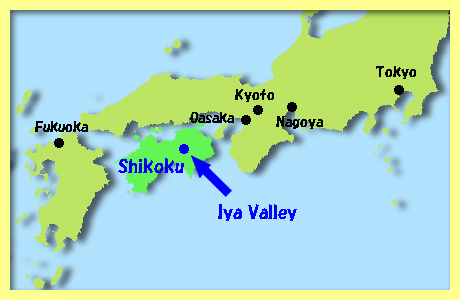
Iya Valley, located in the west of Tokushima Prefecture, Shikoku Region, had been isolated by mountains, rivers and gorges. Such remoteness had provided refugees and samurai losers with retreats. The Taira Clan, who found a hideout in Iya Valley after their having been defeated in the 12th century by Yoritomo Minamoto, the leader of the Minamoto Clan, who established the Kamakura Shogunate ( ==> A History of Japan vol.2 Samurai Age ).
Also the remoteness helped the landscapes, culture and foods of Iya Valley remain as they had been. So many tourists visit the area though the public transformation is not well developed. Rental cars or so would help tourists visit "Achi-Kochi" ( here and there ) in the area.
|
|
Iya Kazura-bashi Bridge
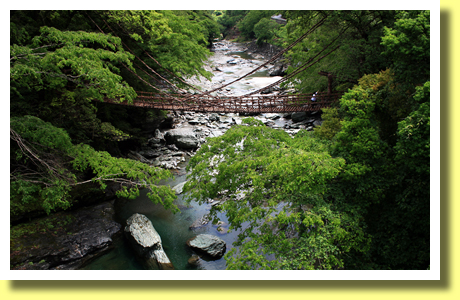
They say that Iya Kazura-bashi Bridge ( a suspension bridge made of mountain vines - above ) was originally constructed in the 12th-13th century by the Taira Clan, samurai refugees. The vine bridge, 45m long and 14m high above the river, is the most popular tourist attractions in Iya Valley.
|
|
Walking across Iya Kazura-bashi Bridge
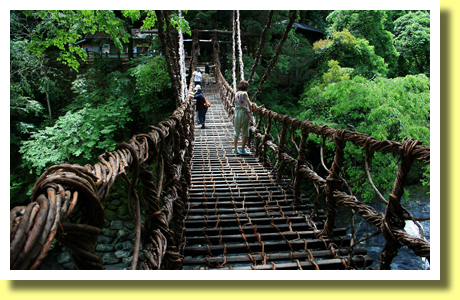
Many tourists, who visit Iya Valley, enjoy walking accross Kazura-bashi Bridge ( above ), which is replaced every three years and is one of Important Tangible Folk Cultural Properties of Japan.
|
|
Look down at the river over the bridge
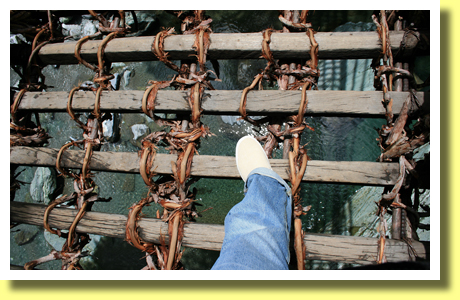
While walking across the vine bridge, tourists could look down at the river ( above ). It could thrill some of the people, though hidden steel cables strengthen the vine bridge.
|
|
Oku-Iya Niju Kazura-bashi Bridges
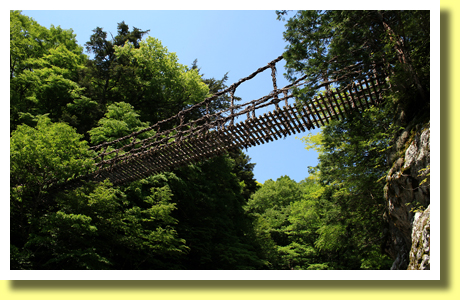
There remain two more vine briges, " Oku-Iya Niju Kazura-bashi Bridges " in Oku-Iya ( or Higashi-Iya ) area. Tourists could walk across the two bridges, one of which is shown in above. A document written in A.D.1657 says that there in Iya Valley were 13 vine bridges, out of which only three remain now.
|
|
Yaen ( human-powered ropeway )
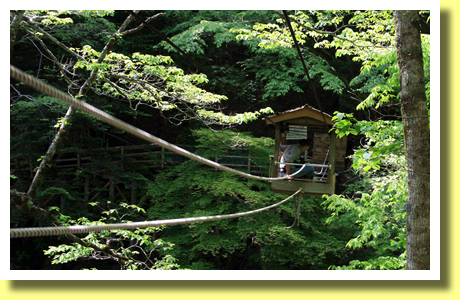
There is an another popular attraction " Yaen " ( above ) near " Oku-Iya Niju Kazura-bashi Bridges ". Though " Yaen " means " wild monkey ", " Yaen " in Oku-Iya area is a human-powered ropeway. It is a small cart to cross the river. Tourists, who would like to try, could pull themselves in the cart.
|
|
Peeing Boy Statue
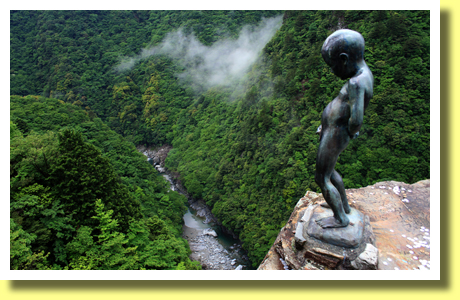
Peeing Boy Statue ( above ), standing on a cliff ( 200m high ) and overlooking a deep gorge, is popular among tourists. It is said that some people, including local young boys, had peed on the cliff to show their nerves. I am anxious about some winds which could blow back the urine as well as the danger.
|
|
Kita-ke House
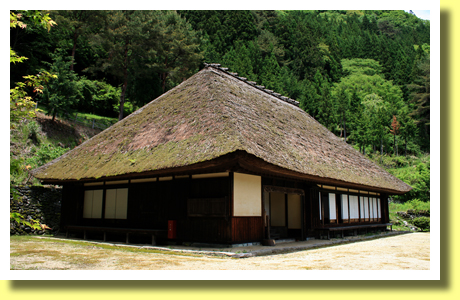
Kita-ke House was a samurai residence built in A.D.1763 by Kita-ke ( Kita Family ), who used to the village headmen. Some say that they were descendants of samurai refugees who found a hideout in Iya Valley in the 12th century. Tourists could see armour and daily necessities in Kita-ke House.
|
|
Scarecrows
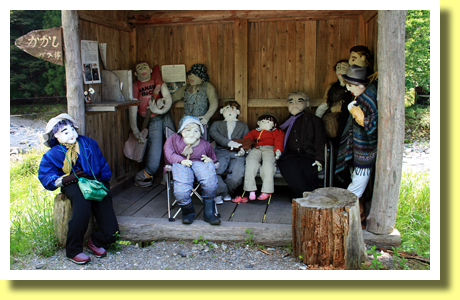
Nagoro hamlet, located in Oku-Iya, is famous for many scarecrows, who have unique personalities as well as their own names. Visitors are welcome by almost 100 scarecrows as above in Nagoro where only 40 or so people live. Nagoro is one of many rural settlements threatened by depopulation and aging.
|
|
Ochiai Hamlet
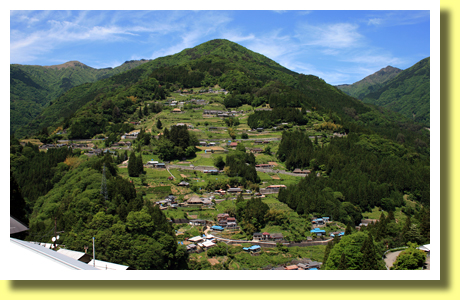
There is very little flat land in Iya Valley. So tourists, visiting Iya Valley, would see hamlets located on steep mountainsides such as Ochiai Hamlet ( above ), where remain houses built a few hundred years ago. The difference between the highest and lowest point of the hamlet is 390m. An observatory is located at the opposite side of the hamlet, which was designated as Important Preservation District of Historic Buildings.
|
|
Soba ( buckwheat noodles )
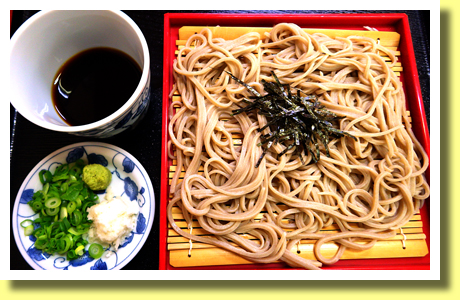
Because of shortage of flat land in Iya Valley, it was far from easy to cultivate rice there. In addition, Iya Valley has good soil and climate to grow buckwheat. So buckwheat became one of the main staples in the area, where tourists could enjoy eating delicious Soba ( buckwheat noodles - above ) in Iya Valley.
Soba noodles are made from soba flour without binding agent traditiojnally in Iya Valley, where soba noodles served are thicker and shorter than those served in other regions.
|
|
Sobagome zosui ( buckwheat porridge )
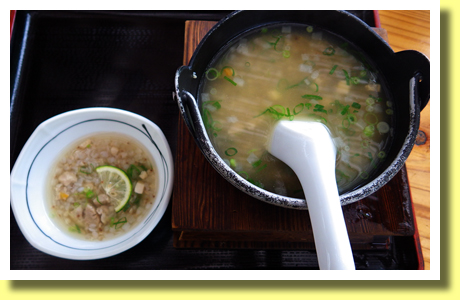
" Sobagome " means buckwheat seeds, boiled in salted water and dried without grinding, while " zosui " means porridge. So " Sobagome zosui "( above ) is buckwheat porridge, which is unique to Iya Valley and one of my most favourite local specialty dishes.
|
|
Deko-mawashi
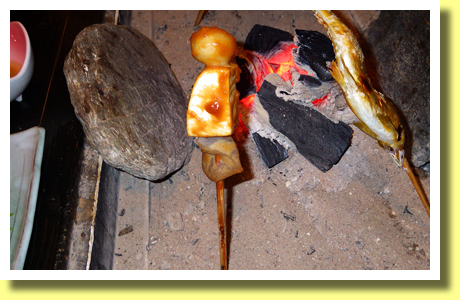
Deko-mawashi ( above ) is another one of local specialty dishes served in the valley. Deko-mawashi is skewered foods such as soba-dango, ishi-tofu and konjac. Soba-dango is a cake made of soba ( buckwheat flour ). Ishi-tofu is bean curd much thicker than those served in other regions. Konjac is a food made from the starch of devil's tongue.
Deko-mawashi is flavoured with miso ( soybean paste ), roasted and spinned over charcoal fire then served. Deko-mawashi being spun looks like a head of " Ningyo " ( puppet ) used in Ningyo Joruri, which is a Japanese traditional puppet theatre. " Deko " means "Ningyo" while "mawashi" means spinning. So " Deko-mawahi " means spinning a head of puppet.
|
|
Oboke Gorge
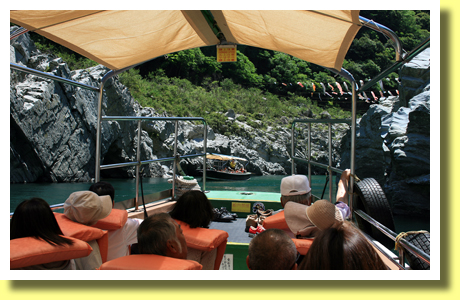
Many tourists visit Oboke Gorge, located in the west of Iya Valley, to enjoy Oboke sightseeing boat cruise ( above ). Oboke Gorge has been created by the swirling rapid current of the Yoshino River and is famous for the landscape. Boat Cruise would help tourists enjoy viewing the amazing scenery.
Also Oboke Gorge is one of the most popular rafting spots. Some companies arrange guided rafting tours, which would help tourists enjoy
one of the fastest currents as well as beautiful natuiral landscapes.
|
|
Chairlift to climb Mt. Tsurugi
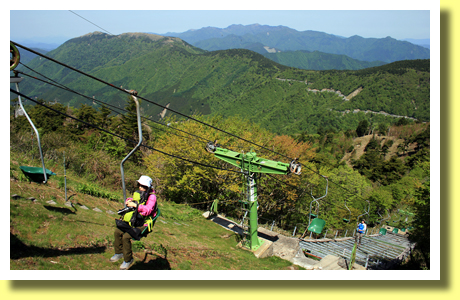
Mt. Tsurugi ( elevation 1,955m ), located at the eastern end of Iya Valley, is the second highest mountain in western Japan. However, chairlifts ( above ) take tourists from Minokoshi station ( elevation 1,420m ) to Nishijima station ( elevation 1,750m ) except winter ( end of November - mid April ).
It takes shorter than one hour to walk up from Minokoshi station to the summit of Mt. Tsurugi. So it could be easy to climb up to the top, though its altitude is nearly 2,000m.
|
|
Mt. Tsurugi
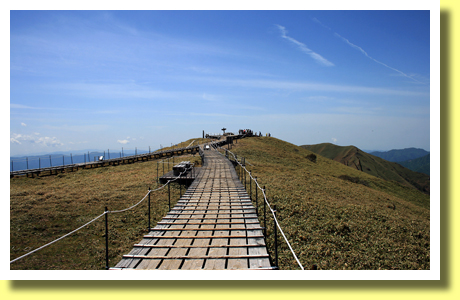
Tourists could walk on wooden paths to the summit ( above ) while enjoying landscapes of mountains surrounding Mt. Tsurugi. " Tsurugi " means a sword. A legend says the sword of Emperor Antoku was buried in the mountain. So it is called " Mt. Tsurugi ". Emperor Antoku, whose mother was from the Taira Clan, shared his fate with the clan in the 12th century. Also Mt. Tsurugi is one of the centres of mountain asceticism. So there are some shrines on and around the mountain.
|
Copyright (c) 2022 Achi-Kochi Zanmai Co., Ltd.
|